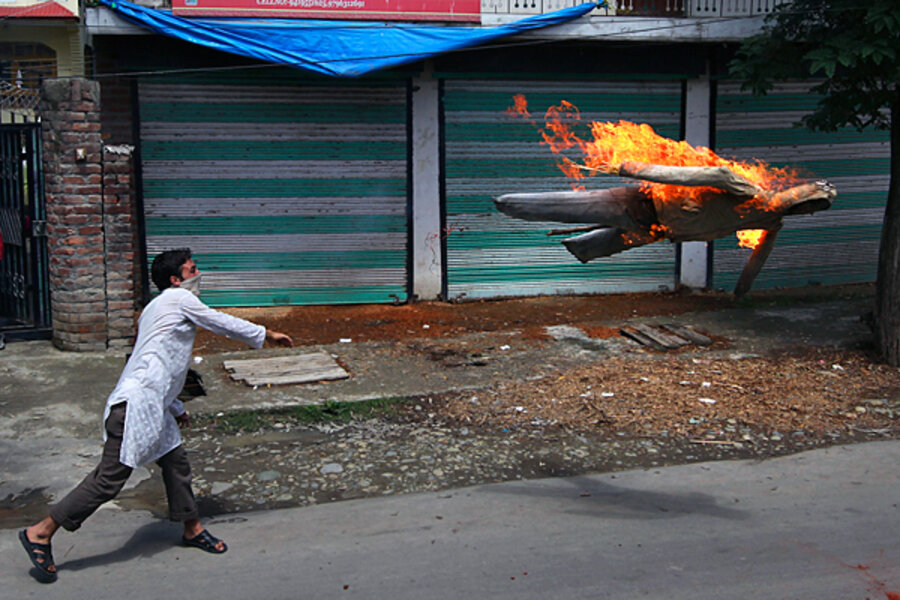India's strategy of suppression in Kashmir could backfire
Loading...
| Srinagar, India
Carefully, in ones and twos, residents of Srinagar emerged from their homes for the first time in a week to pray at small mosques Friday.
Prayers were tense. The city's larger mosques remain blocked by police for the fourth week following the government's imposition of a strict curfew in June, and thousands of Indian security forces were ready to swoop in on any potential protests among pro-independence activists.
Police say only four protests occurred across the Indian-controlled Kashmir region. One protest in Srinagar swelled to 1,000 people, though tear gas quickly broke its ranks. In the village of Palhalan, someone from within the protest crowd shot a police officer twice in the leg.
But separatist leaders and police officials are now warning that the government’s apparent strategy of curfews and suppression lacks a political roadmap and could, in the long run, send the current generation of rock-throwing boys back to the gun-and-grenade warfare that dominated the 1990s. Human rights groups say 19 civilians have died since June 11 in clashes between protesters and security officials.
Kashmir back to the future
“You have the environment that you can push the people again toward what had started in the early '90s. But we don't want that to happen,” says Mirwaiz Umar Farooq, one of the two top separatist leaders. Both are currently under house arrest. “Today boys are out pelting stones. Tomorrow these are the same boys who will probably pick up the gun. ”
He and most Kashmiris say their struggle is not religious at its root, but about self-determination. However, Mr. Farooq warns that the closure of main mosques – smaller mosques have remained open – starts down a dangerous path.
“If the government is not letting the people pray then it’s mandatory for the people at a certain time to declare war against the state. And I think this is something the muftis and the religious scholars will have to think about,” he says.
What separatists want
New Delhi has called for meetings that would involve a wide range of voices, including separatists. But before any dialogue begins, separatists have demanded an easing of draconian security laws, release of prisoners, and pullbacks of street forces. The two sides appear at a standoff.
Observers say tensions run deep across the region, with the influx of Indian security now immobilizing life in much of the Kashmir Valley.
For weeks, dogs and body-armored men have largely had the streets to themselves in downtown Srinagar, the region’s largest city. Residents chalk slogans such as “India Go Back” and “Go India Go” over the roads, hinting at the pervasive frustration here.
The curfew and closure of retail shops has hurt residents, particularly day laborers, which adds pressure each passing day on separatist leaders to urge activists to stand down for now.
“The patience of the people is running out," says Taj Mohudin, minister for irrigation in the Jammu and Kashmir state government. He is among four ministers who form a core group tasked with handling the situation. He says leaders in Delhi from the ruling Congress Party, of which he is a member, “are satisfied with the actions being done.”
As an elder politician, Mr. Mohudin says he’s seen the full 60 years of the struggle in Kashmir for separation. “They talk of independence,” he says. “As a Kashmiri, I feel that first we should be an economically viable state.”
What rock pelting boys and young men say
Conversations with half a dozen rock-pelters, however, revealed only optimism about the economic prospects of an independent Kashmir. None of the youths were themselves unemployed and they denied that economics were key to their motivations.
“Because we are not allowed to protest democratically this is a natural consequence,” says one youth, a doctorate student. “We are not allowed to vent, so stone pelting becomes a spontaneous way to vent.”
None of the youth would give their names for fear of police reprisal. After one interview, police descended on the neighborhood, sending the young men into hiding.
What comes first?
There is a chicken-and-egg situation afoot: Police say they must stop rallies because they turn into rock-throwing mobs, while the rock-throwers say they must throw stones because they cannot rally and, when they do rally, innocents have been killed. Efforts to disperse crowds have resulted in deaths from tear canister shells, bullets, and drownings.
Paramilitary forces are equipped with bamboo shields, face grates, padding, and bullet-proof vests. Police with less. Conversations with members of both forces revealed most had been hit at one point with a stone. Despite their gear, crowds can overwhelm them, particularly from behind.
Police leaders, none of whom could go on record during the tensions, express frustration that they are being asked to solve what they say is ultimately a political problem.
One also warned that the Kashmir valley is a “tinderbox” full of former militants from the 1990s who cannot get jobs because of their past. Estimates range from 25,000 to 40,000 such men, and in recent years they have begun organizing. So far, little has been done to train them or to lift restrictions on getting work.
Related articles:





